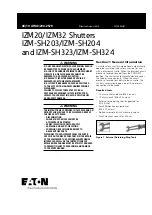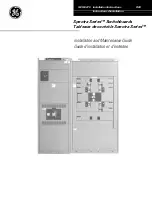
SECTION 7 -Breaker Maintenance (Cont.)
3. Check resistance of the disconnected undervoltage
device. See Table 5 for values.
See i nstruction Sheet GEH-4545 for more detailed infor
mation, including schematic diagrams and circuit descrip
tion.
The undervoltage device must be calibrated through the
time-delay unit after the device pick up has been adjusted.
A .008 inch minimum closed gap must exist between the ar
mature and magnet as shown i n Fig. 32C. Refer to Section
7.8.3 and Table 24.
7.10 ELECTRIC LOCKOUT DEVICE
The electric lockout device utilizes an undervoltage
device to keep the breaker from resetting its mechanism if
the breaker is open and the undervoltage device coil is not
energized. The breaker thus cannot be closed unless
voltage is on the. coil. Once the breaker is closed, loss-of
voltage will not trip the breaker because, in the closed posi
tion, a mechanical link is used to hold down the armature of
the device. See Fig.
33.
This arrangement provides a
means of electrically i nterlocking two breakers so that they
cannot be closed at the same time. Each undervoltage coil
may be wired in series with a "B" auxiliary switch contact
on the other breaker for cross-interlock purposes.
On each breaker having an electric lockout, an arrange
ment is made which
will
allow breaker closing with the coi l
de-energized. This is provided to allow "start-up': o n "dead"
systems. Figure
34
shows this device. The push slide
shown is located in the opening in the lower part of the
escutcheon. This breaker door must be opened to gain
access to it.
26
MAI N SHAFT
( BREAKER CLOSED)
:�/-
��/
\
'
-
I
�
.
"--' ___) :
·-�
--
. /
lL'i
HOLD- IN
I
:
L I NK
.'
· ---._
r
11·1
FIG. 34
-
ELECTRIC LOCKOUT BY-PASS
FIG. 33
-
ELECTRIC LOCKOUT DEVICE
7.1 1
BELL ALARM
This device is used to give a remote indication of the
breaker having tripped open through the action
1
of one of
its automatic protective devices. It will not be activated by
manual tripping or the action of the shunt trip. A remotely
mounted protective relay energizing the shunt trip wil l there
fore not result in the remote alarm action.
The bell alarm circuit may be turned off by pushing in the
manual trip or by energizing the shunt trip. In the l atter case,
a normally open contact of the bel l alarm switch must be
wired in parallel with the "A" auxiliary switch contact i n the
shunt-trip circuit. Closing the breaker will also turn off the
alarm.
The bell alarm device may be equipped with a lockout
link which will lock the breaker open until the bell alarm
device is reset.
The bel l alarm is not a standard device and is supplied
only when specified on the breaker order.
7.1 1 .1
OPERATION
Referring to Fig.
35:
the bel l alarm mechanism is ac
tivated by a crank which is assembled to the breaker's
main
shaft. When the breaker opens, a pin attached to this crank
moves the alarm link against the switch and locklever (if
provided). Thi s activates the switch contacts. It also moves
the locklever adjustment screw against the trip shaft paddle
keeping the breaker trip free .
LATCH ENGAGEMENT
POINT
FIG. 35
-
BELL ALARM DETAILS
www
. ElectricalPartManuals
. com
















































